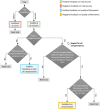Automating provision of feedback to stroke patients with and without information on compensatory movements: A pilot study
- PMID: 36003313
- PMCID: PMC9393297
- DOI: 10.3389/fnhum.2022.918804
Automating provision of feedback to stroke patients with and without information on compensatory movements: A pilot study
Abstract
Providing effective feedback to patients in a rehabilitation training program is essential. As technologies are being developed to support patient training, they need to be able to provide the users with feedback on their performance. As there are various aspects on which feedback can be given (e.g., task success and presence of compensatory movements), it is important to ensure that users are not overwhelmed by too much information given too frequently by the assistive technology. We created a rule-based set of guidelines for the desired hierarchy, timing, and content of feedback to be used when stroke patients train with an upper-limb exercise platform which we developed. The feedback applies to both success on task completion and to the execution of compensatory movements, and is based on input collected from clinicians in a previous study. We recruited 11 stroke patients 1-72 months from injury onset. Ten participants completed the training; each trained with the rehabilitation platform in two configurations: with motor feedback (MF) and with no motor feedback (control condition) (CT). The two conditions were identical, except for the feedback content provided: in both conditions they received feedback on task success; in the MF condition they also received feedback on making undesired compensatory movements during the task. Participants preferred the configuration that provided feedback on both task success and quality of movement (MF). This pilot experiment demonstrates the feasibility of a system providing both task-success and movement-quality feedback to patients based on a decision tree which we developed.
Keywords: compensatory movements; exergames; human-computer interface; human-machine interface; patient-centered design; serious games; stroke; user experience.
Copyright © 2022 Fruchter, Feingold Polak, Berman and Levy-Tzedek.
Conflict of interest statement
The authors declare that the research was conducted in the absence of any commercial or financial relationships that could be construed as a potential conflict of interest.
Figures





Similar articles
-
Increasing upper limb training intensity in chronic stroke using embodied virtual reality: a pilot study.J Neuroeng Rehabil. 2017 Nov 17;14(1):119. doi: 10.1186/s12984-017-0328-9. J Neuroeng Rehabil. 2017. PMID: 29149855 Free PMC article. Clinical Trial.
-
A robot goes to rehab: a novel gamified system for long-term stroke rehabilitation using a socially assistive robot-methodology and usability testing.J Neuroeng Rehabil. 2021 Jul 28;18(1):122. doi: 10.1186/s12984-021-00915-2. J Neuroeng Rehabil. 2021. PMID: 34321035 Free PMC article. Clinical Trial.
-
Real-time auditory feedback may reduce abnormal movements in patients with chronic stroke.Disabil Rehabil. 2023 Feb;45(4):613-619. doi: 10.1080/09638288.2022.2037751. Epub 2022 Mar 3. Disabil Rehabil. 2023. PMID: 35238694 Clinical Trial.
-
Technology-assisted training of arm-hand skills in stroke: concepts on reacquisition of motor control and therapist guidelines for rehabilitation technology design.J Neuroeng Rehabil. 2009 Jan 20;6:1. doi: 10.1186/1743-0003-6-1. J Neuroeng Rehabil. 2009. PMID: 19154570 Free PMC article. Review.
-
Embracing change: practical and theoretical considerations for successful implementation of technology assisting upper limb training in stroke.J Neuroeng Rehabil. 2012 Aug 2;9:52. doi: 10.1186/1743-0003-9-52. J Neuroeng Rehabil. 2012. PMID: 22856548 Free PMC article. Review.
Cited by
-
Online detection of compensatory strategies in human movement with supervised classification: a pilot study.Front Neurorobot. 2023 Jul 14;17:1155826. doi: 10.3389/fnbot.2023.1155826. eCollection 2023. Front Neurorobot. 2023. PMID: 37520678 Free PMC article.
-
The Use of Extrinsic Performance Feedback and Reward to Enhance Upper Limb Motor Behavior and Recovery Post-Stroke: A Scoping Review.Neurorehabil Neural Repair. 2025 Feb;39(2):157-173. doi: 10.1177/15459683241298262. Epub 2024 Dec 11. Neurorehabil Neural Repair. 2025. PMID: 39659261 Free PMC article.
References
-
- Brooke J. (2013). SUS: a retrospective. J. Usability Stud. 8 29–40.
LinkOut - more resources
Full Text Sources
Research Materials

